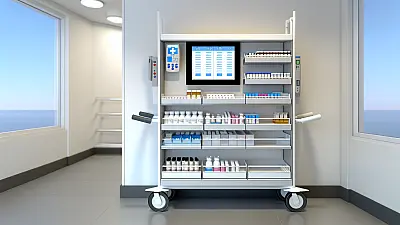SANTA ANA, CA - State health inspectors documented multiple failures in medical equipment management at The Hills Post Acute nursing facility, including improper maintenance of intravenous lines for five residents and unsafe oxygen therapy practices that created infection risks and potential complications for vulnerable patients.

Critical IV Line Maintenance Failures Affected Multiple Residents
During a March 2025 inspection, investigators found systematic failures in the facility's management of peripherally inserted central catheter (PICC) lines, midline catheters, and peripheral IV access across five residents. These specialized medical devices require precise monitoring and regular maintenance to prevent life-threatening complications.
The most concerning findings involved Resident 24, whose PICC line dressing had not been changed since March 4, despite facility protocols requiring weekly changes. When inspectors arrived on March 19, the dressing was visibly loose after 15 days without replacement. PICC lines provide direct access to major blood vessels near the heart, making proper maintenance critical for preventing bloodstream infections that can quickly become fatal in elderly patients.
Staff failed to document required measurements of arm circumference and external catheter length - essential monitoring steps that help detect early signs of infection, blood clots, or catheter migration. These measurements serve as baseline comparisons to identify swelling, which can indicate serious complications like deep vein thrombosis or infection spreading through surrounding tissues. The facility's electronic documentation system allowed nurses to bypass these requirements by entering "N/A" instead of actual measurements.
Similarly, Resident 125's midline IV catheter showed evidence of neglected maintenance. The dressing dated March 2 remained unchanged for over two weeks when inspectors observed it on March 17. Midline catheters, while not extending as deeply as PICC lines, still pose significant infection risks when dressings become compromised. Bacteria can migrate along the catheter tract, potentially causing cellulitis, abscess formation, or systemic infection.
Oxygen Therapy Administered Without Physician Authorization
Perhaps most alarming was the discovery that Resident 123 received continuous oxygen therapy at 2 liters per minute without any physician's order authorizing the treatment. The resident had been readmitted to the facility with pneumonia, yet staff administered oxygen therapy throughout multiple shifts without proper medical authorization.
Administering oxygen without medical oversight poses serious risks. Excessive oxygen in patients with certain lung conditions can suppress their respiratory drive, potentially leading to carbon dioxide retention and respiratory failure. For pneumonia patients, oxygen levels must be carefully calibrated to maintain adequate blood oxygen while avoiding oxygen toxicity, which can worsen lung inflammation.
When inspectors observed Resident 123's room, they found oxygen tubing and nasal cannula lying directly on the floor beside the bed - a severe breach of infection control protocols. Floor contamination introduces bacteria, viruses, and fungal spores directly into equipment that delivers oxygen to already compromised lungs. For a resident recovering from pneumonia, this contamination pathway significantly increases the risk of secondary respiratory infections.
Documentation Failures Prevented Proper Monitoring
The facility's documentation failures extended beyond missing measurements. Resident 139 had a peripheral IV line in place for hydration therapy, yet staff failed to obtain physician orders for maintenance care or develop a care plan addressing the IV site. The registered nurse on duty was unaware the IV line existed until inspectors pointed it out.
Peripheral IV sites require assessment every shift for signs of infiltration, phlebitis, or infection. Without documented monitoring protocols, early warning signs of complications go undetected. Infiltration occurs when IV fluid leaks into surrounding tissue, potentially causing severe tissue damage. Phlebitis - vein inflammation - can progress to thrombophlebitis and increase risks of dangerous blood clots.
Resident 145's peripheral IV lacked basic labeling showing insertion date, time, and the inserting nurse's initials. This fundamental documentation helps ensure IV sites are changed before the maximum seven-day limit, reducing infection risk. The facility's own policies require peripheral IV sites be assessed for complications and flushed with saline every 12 hours when not actively infusing medications, yet no maintenance orders existed until three days after the IV was placed.
Systemic Training and Oversight Deficiencies
The pattern of violations revealed systemic problems with staff training and oversight. The MDS Coordinator acknowledged that "additional education might be necessary" when unable to locate documentation of required measurements. Multiple nurses demonstrated confusion about documentation requirements and maintenance schedules for different types of vascular access devices.
Industry standards require comprehensive training on vascular access device management, including device-specific protocols for PICC lines, midline catheters, and peripheral IVs. Each device type carries different risk profiles and maintenance requirements. PICC lines require sterile dressing changes with maximum barrier precautions, while peripheral IVs need regular site rotation to prevent complications.
The facility's electronic medical record system contributed to the problem by allowing nurses to enter "N/A" for required measurements rather than forcing documentation of actual values. This system design flaw enabled staff to bypass critical safety checks meant to detect early signs of complications.
Additional Issues Identified
Beyond the primary IV and oxygen therapy violations, inspectors documented failures in respiratory equipment maintenance for multiple residents. Oxygen tubing and humidifier bottles lacked required date labels indicating when equipment was last changed. One resident's oxygen supplies were stored in an unsanitary manner without proper labeling. The facility's infection control practices showed widespread deficiencies in maintaining sterile technique and preventing cross-contamination. Care plans were initiated late or missing entirely for residents with complex medical devices.
These violations occurred despite clear facility policies requiring weekly dressing changes, routine measurements, proper documentation, and sanitary equipment storage. The disconnect between written policies and actual practice suggests inadequate supervision and quality assurance systems to ensure compliance with established protocols. The pattern of failures across multiple units and different types of medical equipment indicates these were not isolated incidents but rather reflected facility-wide systemic deficiencies requiring comprehensive corrective action.
Full Inspection Report
The details above represent a summary of key findings. View the complete inspection report for The Hills Post Acute from 2025-03-24 including all violations, facility responses, and corrective action plans.
💬 Join the Discussion
Comments are moderated. Please keep discussions respectful and relevant to nursing home care quality.